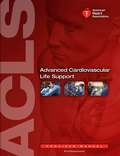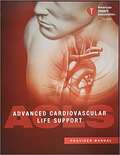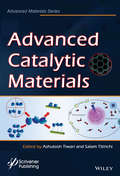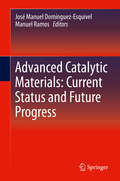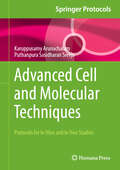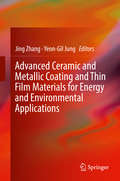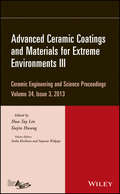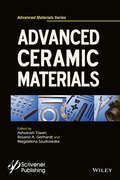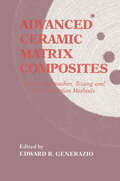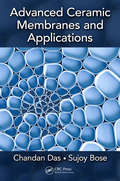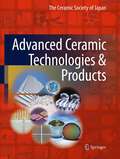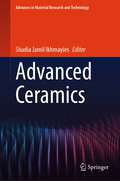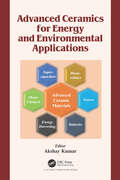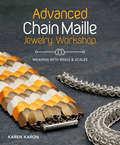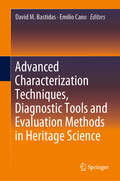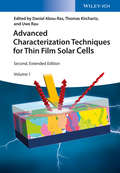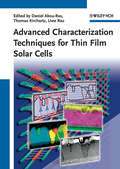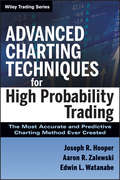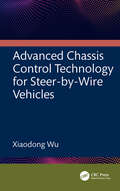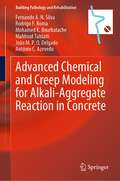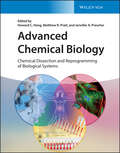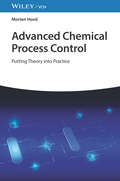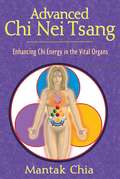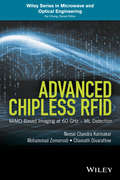- Table View
- List View
Advanced Cardiovascular Life Support: Provider Manual
by American Heart AssociationHealthcare providers use a systematic approach to assess and treat arrest and acutely ill or injured patients for optimum care. The goal of the resuscitation team's interventions for a patient in respiratory or cardiac arrest is to support and restore effective oxygenation, ventilation, and circulation with return of Intact neurologic function.
Advanced Cardiovascular Life Support (ACLS) Provider Manual
by American Heart AssociationThis manual bundle contains all the information students need to successfully complete the BLS, ACLS, & PALS courses in a classroom-based format. Designed for use by a single student, this text is also ideal for use as a reference tool before and after the course. Full-color softcovers, BLS Quick Reference Guide, the ACLS & PALS Precourse Preparation Checklist Card, and the ACLS & PALS Pocket Reference Card sets. Based on the 2015 American Heart Association Guidelines for CPR and ECC.
Advanced Catalytic Materials
by Ashutosh Tiwari Salam TitinchiThe subject of advanced materials in catalysisbrings together recent advancements in materials synthesis and technologies to the design of novel and smart catalysts used in the field of catalysis. Nanomaterials in general show an important role in chemical processing as adsorbents, catalysts, catalyst supports and membranes, and form the basis of cutting-edge technology because of their unique structural and surface properties. Advanced Catalytic Materials is written by a distinguished group of contributors and the chapters provide comprehensive coverage of the current literature, up-to-date overviews of all aspects of advanced materials in catalysis, and present the skills needed for designing and synthesizing advanced materials. The book also showcases many topics concerning the fast-developing area of materials for catalysis and their emerging applications. The book is divided into three parts: Nanocatalysts - Architecture and Design; Organic and Inorganic Catalytic Transformations; and Functional Catalysis: Fundamentals and Applications. Specifically, the chapters discuss the following subjects: * Environmental applications of multifunctional nanocomposite catalytic materials * Transformation of nanostructured functional precursors using soft chemistry * Graphenes in heterogeneous catalysis * Gold nanoparticles-graphene composites material for catalytic application * Hydrogen generation from chemical hydrides * Ring-opening polymerization of poly(lactic acid) * Catalytic performance of metal alkoxides * Cycloaddition of CO2 and epoxides over reusable solid catalysts * Biomass derived fine chemicals using catalytic metal bio-composites * Homoleptic metal carbonyls in organic transformation * Zeolites: smart materials for novel, efficient, and versatile catalysis * Optimizing zeolitic catalysis for environmental remediation
Advanced Catalytic Materials: Current Status and Future Progress
by José Manuel Domínguez-Esquivel Manuel RamosThis book presents advances in computational methods, experimental synthesis, and advanced characterizations for novel catalytic materials. The authors show how catalytical materials can be used for various engineering oil & gas applications – mainly in low contaminants fuel production. All contributors, describe in detail novel experimental and theoretical techniques techniques and concepts for synthesis, evaluation and scaling catalytic materials and research advances in evaluation, extensive characterization and theoretical modeling using computer assisted methods and algorithms.Describes computational methods, experimental synthesis and advanced characterization for novel catalytic materials;Examines catalytic materials and corresponding engineering applications with a focus on low contaminant fuel production and derivatives;Covers the application of computer assisted quantum mechanical for fundamental understanding of electronic structure of molecular dimension catalytic materials.
Advanced Cell and Molecular Techniques: Protocols for In Vitro and In Vivo Studies (Springer Protocols Handbooks)
by Karuppusamy Arunachalam Puthanpura Sasidharan SreejaThis detailed volume explores laboratory protocols and methodologies for studying cell cultures, genetic analysis, and various biochemical assays. The chapters within this book cover a wide range of techniques, from basic cell culture methods to more specialized assays used in the study of genotoxicity, apoptosis, and gene expression, not only relevant to academic researchers but also to professionals in the pharmaceutical, biotechnological, and clinical fields. Written for the Springer Protocols Handbooks series, each protocol has been carefully compiled to provide step-by-step instructions, ensuring clarity and reproducibility. Authoritative and practical, Advanced Cell and Molecular Techniques: Protocols for In Vitro and In Vivo Studies serves as both a hands-on guide and a source of inspiration for future research as the fields of molecular biology and toxicology continue to evolve.
Advanced Ceramic and Metallic Coating and Thin Film Materials for Energy and Environmental Applications
by Jing Zhang Yeon-Gil JungThis book explores the recent developments, perspectives on future research, and pertinent data from academia, industry, and government research laboratory to discuss fundamental mechanisms as well as processing and applications of advanced metallic and ceramic thin film and coating materials for energy and environmental applications. It is a platform to disseminate the latest research progress related to processing, characterization, and modelling. The authors address both thermal barrier and environmental coatings; magnetic and thermoelectric materials; and solar cell and solid oxide fuel cell materials. It is appropriate supplementary reading for students and primary reading for researchers in materials science and engineering.
Advanced Ceramic Coatings and Materials for Extreme Environments III: Ceramic Engineering and Science Proceedings, Volume 34 Issue 3
by Soshu Kirihara Sujanto Widjaja Hua-Tay Lin Taejin HwangCeramic Engineering and Science Proceedings Volume 34, Issue 3 - Advanced Ceramic Coatings and Materials for Extreme Environments III A collection of 12 papers from The American Ceramic Society's 37th International Conference on Advanced Ceramics and Composites, held in Daytona Beach, Florida, January 27-February 1, 2013. This issue includes papers presented in the Advanced Ceramic Coatings and Systems and Next Generation Technologies for Innovative Surface Coatingssymposia.
Advanced Ceramic Materials
by Magdalena Szutkowska Ashutosh Tiwari Rosario A. GerhardtCeramic materials are inorganic and non-metallic porcelains, tiles, enamels, cements, glasses and refractory bricks. Today, "ceramics" has gained a wider meaning as a new generation of materials influence on our lives; electronics, computers, communications, aerospace and other industries rely on a number of their uses. In general, advanced ceramic materials include electro-ceramics, optoelectronic-ceramics, superconductive ceramics and the more recent development of piezoelectric and dielectric ceramics. They can be considered for their features including mechanical properties, decorative textures, environmental uses, energy applications, as well as their usage in bio-ceramics, composites, functionally graded materials, intelligent ceramics and so on. Advanced Ceramic Materials brings together a group of subject matter experts who describe innovative methodologies and strategies adopted in the research and development of the advanced ceramic materials. The book is written for readers from diverse backgrounds across chemistry, physics, materials science and engineering, medical science, pharmacy, environmental technology, biotechnology, and biomedical engineering. It offers a comprehensive view of cutting-edge research on ceramic materials and technologies. Divided into 3 parts concerning design, composites and functionality, the topics discussed include: Chemical strategies of epitaxial oxide ceramics nanomaterials Biphasic, triphasic and multiphasic calcium orthophosphates Microwave assisted processing of advanced ceramic composites Continuous fiber reinforced ceramic matrix composites Yytria and magnesia doped alumina ceramic Oxidation induced crack healing SWCNTs vs MWCNTs reinforcement agents Organic and inorganic wastes in clay brick production Functional tantalum oxides Application of silver tin research on hydroxyapatite
Advanced Ceramic Matrix Composites: esign Approaches,Testing and L
by Edward R. GenerazioAdvanced ceramic composites are the focus of intense research and development today because these materials offer a unique mix of properties that make them useful and economical for major engineering applications. As part of this R&D effort, new tools for characterization, evaluation and testing have been developed and are in current use.This book brings together leading materials researchers to report on these developments. In-depth reports cover evaluation and test methods as they relate to the design of specific advanced ceramic composite materials and their applications. The reports are supplemented with extensive test result data and illustrated with numerous micrographs and schematics.
Advanced Ceramic Membranes and Applications
by Chandan Das Sujoy BoseThis book provides a balanced blend of fundamental concepts of fabrication, characterization of conventional ceramics, extending to present the recent advances in ceramic membranes. It covers the basic concepts of ceramic membranes as well as practical and theoretical knowledge in conventional and advanced ceramic membranes combined with unorthodox ideas for novel approaches in ceramic membranes. Book includes lot of real time examples derived largely from research work by authors. Aimed at researchers, students and academics in the field of membrane engineering around the globe, it has following key features: Guides readers through manufacturing, characterizing and using low-cost ceramic technology. Provides an overview of the different types of ceramic membranes, catalytic reactors and their uses. Covers industrial application, separation and purification. Includes recent developments and advances in membrane fabrication. Discusses new raw materials for ceramic membranes.
Advanced Ceramic Technologies & Products
by The Ceramic Society of JapanSince the last century, ceramics have become essential to modern society and our daily lives. They have become an indispensable product to many industries, especially within the fields of electronics, automobiles, medicine, and leisure. Japanese ceramic technologies and products are highly sophisticated and world renown, and ceramic products have long contributed to Japanese society. The true significance of ceramics to modern society however, is not well understood. This book describes in detail the background to and objective of the development, materials, manufacturing processes, functions and future prospects of a number of ceramic products. Not merely about the science and technology of ceramic manufacturing, the book is about the products themselves, as it tries to clarify how ceramics continue to contribute to our lives. It is the first such work to show advanced ceramic products in detail, from the technologies used to their application, and can be seen as a kind of illustrated reference book for modern advanced ceramic products as it is filled with easy-to-understand illustrations and photos. By including past and current product technologies, the editors hope the book will serve to guide engineers and the manufacturing sector toward a bright future of innovations for the benefit of us all.
Advanced Ceramics (Advances in Material Research and Technology)
by Shadia Jamil IkhmayiesThis book presents the fundamentals of advanced ceramics, their stages of development, types and classifications, advanced processing techniques, properties, sintering, and new forms of applications. It highlights specific examples such as alumina, zirconia, Mg-Al-spinels, silicon carbide, silicon nitride, ceramic composites, and thin films with their specific applications. The book reviews progress in perovskite ceramics, in which the synthesis, processing, characterization, and advanced applications of perovskite ceramics are all thoroughly discussed. In addition, developments of perovskite solar cells, the main factors affecting their stability, current problems, development prospects in the research, and application of perovskite solar cells are all highlighted. This book also includes a review of a particular class of rare-earth-based mixed-metal oxides, namely Ln2B2O7 nanostructures (B = Zr, Sn, and Ce), where advantages and disadvantages of each production technique are addressed along with the properties of as-produced nanostructures. The solar photocatalytic uses of Ln2B2O7 nanostructures such as photodegradation of contaminants are also discussed. Yttria-based transparent ceramics for photonic applications are reviewed, along with a discussion of powder synthesis, green body preparation, sintering, and optical properties. In addition, the fundamentals of electrophoretic deposition of hydroxyapatite incorporated composite coatings on metallic substrates are presented and discussed. The different types of ceramics-based self-healing coatings and their fabrication processes have also been reported and discussed in this book. These include titania, zirconia, titanium-alumina, and zirconia-alumina incorporated with Benzotriazole (BTA) as an inhibitor. Advanced ceramic materials that have been used for the purpose of wastewater treatment including ceramic sorbents, resins, aerosols, and ceramic membranes that have been widely used for wastewater treatment purposes are also discussed in depth.Moreover, the book presents the preparation of geopolymers by microwave treatments and explains how their properties can be tuned using microwaves. Furthermore, the future and perspective of these advanced ceramic materials and their modifications to ensure better efficacy toward environmental remediation purposes are highlighted in this book.
Advanced Ceramics for Energy and Environmental Applications
by Akshay KumarAdvanced Ceramics possess various unique properties and are able to withstand harsh environments. The aim of this book is to cover various aspects of the advanced ceramics like carbides, nitrides and oxides for energy and environment related applications. Advanced ceramics with additional functionality propose significant potential for greater impact in the field of energy and environmental technologies. This book focuses on the nanostructured ceramics synthesis, properties, structure-property relation and application in the area of energy and environment. It covers the high impact work from around 50 leading researchers throughout the world working in this field. This will help metallurgists, biologists, mechanical engineers, ceramicists, material scientists and researchers working in the nanotechnology field with inclusion of every aspect of advanced ceramics for energy and environmental applications.
Advanced Chain Maille Jewelry Workshop: Weaving with Rings and Scale Maille
by Karen KaronChain maille patterns and weaves that take jewelry design into new frontiers! Jewelry artists will enjoy a collection of new, less-common weaves and challenging projects that inspire and educate. Author Karen Karon begins by reviewing basic chain maille weaves in order to set the stage for the more complex weaves in this book. She explains techniques needed when working beyond the basics: methods for closing a weave, working with micro rings, working large scale, and using alternative materials in weaves. The book is then divided into 4 sections, each devoted to a particular type of weave: new Persian weaves, Elf-based weaves, Hybrid weaves, and Scale Maille weaves that incorporate sheet metal scales into traditional weaves for a striking effect. Sprinkled throughout the illustrated step-by-step instructions for each weave technique are valuable tips from Karen to help ensure a beautiful finished piece.
Advanced Characterization Techniques, Diagnostic Tools and Evaluation Methods in Heritage Science
by David M. Bastidas Emilio CanoThis book details the application of advanced characterisation techniques and diagnostic tools to heritage science, including the evaluation of heritage assets’ condition, their preservation and restoration. <p><p> It examines the use of electrochemical techniques in conservation science, with a particular focus on how to solve problems in taking on-site measurements. Specifically, it introduces readers to a new gel polymer (GPE) electrochemical cell developed by the authors for the characterisation of metallic heritage objects. Other techniques used to characterise and monitor reinforced concrete objects in more modern buildings are also covered, including non-destructive electrochemical techniques that allow steel corrosion to be assessed in these structures, and in those that are used to protect and repair such buildings. <p> The usefulness of the NMR-Mouse nuclear magnetic resonance sensor in the assessment and preservation of softer heritage materials, such as wood, parchment, bone, and painted walls, is covered, as well as Infrared reflectography for examining paintings and laser cleaning for restoring them. The book introduces ultra-High Performance Liquid Chromatography (u-HPLC) with a diode-array (DAD) and mass–mass (MS-MS) quadruple time-of-flight spectroscopy (QTOF). This new technique can be applied to the analysis and identification of natural and synthetic organic pigments and its use is demonstrated in several case studies. <p> This book provides a rigorous scientific grounding in the application of state-of-the-art techniques in heritage science and conservation, and offers a practical handbook for practitioners.
Advanced Characterization Techniques for Thin Film Solar Cells
by Daniel Abou-Ras Uwe Rau Thomas KirchartzThe book focuses on advanced characterization methods for thin-film solar cells that have proven their relevance both for academic and corporate photovoltaic research and development. After an introduction to thin-film photovoltaics, highly experienced experts report on device and materials characterization methods such as electroluminescence analysis, capacitance spectroscopy, and various microscopy methods. In the final part of the book simulation techniques are presented which are used for ab-initio calculations of relevant semiconductors and for device simulations in 1D, 2D and 3D. Building on a proven concept, this new edition also covers thermography, transient optoelectronic methods, and absorption and photocurrent spectroscopy.
Advanced Characterization Techniques for Thin Film Solar Cells
by Daniel Abou-Ras Uwe Rau Thomas KirchartzWritten by scientists from leading institutes in Germany, USA and Spain who use these techniques as the core of their scientific work and who have a precise idea of what is relevant for photovoltaic devices, this text contains concise and comprehensive lecture-like chapters on specific research methods. They focus on emerging, specialized techniques that are new to the field of photovoltaics yet have a proven relevance. However, since new methods need to be judged according to their implications for photovoltaic devices, a clear introductory chapter describes the basic physics of thin-film solar cells and modules, providing a guide to the specific advantages that are offered by each individual method. The choice of subjects is a representative cross-section of those methods enjoying a high degree of visibility in recent scientific literature. Furthermore, they deal with specific device-related topics and include a selection of material and surface/interface analysis methods that have recently proven their relevance. Finally, simulation techniques are presented that are used for ab-initio calculations of relevant semiconductors and for device simulations in 1D and 2D. For students in physics, solid state physicists, materials scientists, PhD students in material sciences, materials institutes, semiconductor physicists, and those working in the semiconductor industry, as well as being suitable as supplementary reading in related courses.
Advanced Charting Techniques for High Probability Trading
by Edwin L. Watanabe Aaron R. Zalewski Joseph R. HooperAn all-star team of trading experts describe an array of proven charting techniques to bolster any portfolio*Purchase includes a 30-day free trial of Advanced Charting Platinum Selections software and generate returns of up to 3 percent per day.*There are over 175 recognized technical indicators that have been developed by traders, mathematicians and chartists to help traders make more accurate predictions about the price movements of individual securities, asset classes and the market as a whole. These technical indicators are never used alone but applied in various combinations. Developed and tested over many years by the authors, the highly reliable strategies described in this book combine a variety of charting techniques, which, when used in conjunction, have been shown to yield extremely accurate predictions about a stock's movements through the four cyclical phases of Birth, Momentum, Exhaustion and Death.You get powerful strategies, using a range of technical indicators, guaranteed to significantly improve your ability to more accurately--and profitably--time buy, hold and sell decisionsThe material in this book is currently required reading for the authors' prestigious Compound Stock Earnings (CSE) charting courseIncludes a special link to the main CSE website where you'll find a treasure trove of additional content, updates, and instructional videos and podcastsProvides valuable insights and information about the Covered Call approach to trading, a style about which Joseph R. Hooper is an internationally recognized expert
Advanced Chassis Control Technology for Steer-by-Wire Vehicles
by Xiaodong WuAdvanced Chassis Control Technology for Steer-by-Wire Vehicles details state-of-the-art drive-by-wire technology, enabling engineers to create safer and smarter steering technology. With applications in Formula 1 driving, this book is an accessible yet ambitious introduction to the technology that is fast becoming the future of road vehicles.Steer-by-wire systems replace conventional mechanical technology with electronic sensors, controllers, and actuators, enhancing functionality when steering. Features such as variable steer ratio, customized road feel, and advanced vehicle dynamics control all ensure that this maximizes safety when driving. The book looks first at the theory behind this technology and compares it to conventional mechanical steering. It discusses control through forward and backward dynamics and a shared steering control concept to improve vehicle handling and performance, relevant to intelligent vehicles. It also explains how to create chassis domain fusion control, four independent wheels steering system and teleoperated control. Using case studies and ISOs, the book is a practical guide to safely designing steer-by-wire systems.The book is an essential guide to all engineers working in the modern automotive industry.
Advanced Chemical and Creep Modeling for Alkali-Aggregate Reaction in Concrete (Building Pathology and Rehabilitation #28)
by Fernando A. Silva Rodrigo F. Roma Mohamed K. Bourbatache Mahfoud Tahlaiti João M. Delgado António C. AzevedoThis book presents the numerical results of the use of the chemical model to analyse the advancement of the reaction and the mechanical model to simulate creep and shrinkage phenomena in COMSOL Multiphysics®, as a way to reassess concrete structures suffering from those mechanisms. Both models were implemented separately to evaluate their responses and compare them with the theoretical results and experimental benchmarks presented in the literature. The numerical simulation results showed excellent agreement with the experimental results data, with maximum disagreement not exceeding 10%, indicating that the implementation of the developed numerical models behaved very efficiently.
Advanced Chemical Biology: Chemical Dissection and Reprogramming of Biological Systems
by Howard HangAdvanced Chemical Biology The modern approach to teaching chemical biology Advanced Chemical Biology is organized around the central dogma of life, progressing from genes to proteins and higher-order cellular structures, including core application areas such as imaging, chemical genetics, activity-based protein profiling, and natural product discovery and biosynthesis. Advanced topics and applications in, e. g., microbiology, developmental biology, and neurobiology, are covered in separate sections. Every chapter is homogeneous in style and layout, consisting of a short historical introduction followed by a description of the underlying concepts and a selection of recent examples of how the concept has been turned into practice. The subdivision of the contents into core and supplemental chapters enables a flexible use in teaching, both for a one-semester and a two-semester course. Written by authors and editors coming from the leading scientific institutions that have developed the concepts and technologies for this discipline, Advanced Chemical Biology includes specific information on topics like: DNA function, synthesis and engineering, chemical approaches to genome integrity, and RNA function, synthesis, and probing Chemical approaches to transcription and RNA regulation in vivo, chemical biology of genome engineering, and peptide/protein synthesis and engineering Directed evolution for chemical biology, chemical biology of cellular metabolism, chemical biology of lipids, and protein post-translational modifications Chemical glycobiology, chemical and enzymatic modification of proteins, genetic code expansion, bio-orthogonal chemistry, and cellular imaging With its broad scope and focus on turning concepts into applications, Advanced Chemical Biology is an excellent starting point for anyone entering the field and looking for a guide to the wide range of available methods and strategies that chemical biology has to offer. With a Foreword by Nobel Laureate Carolyn Bertozzi.
Advanced Chemical Process Control: Putting Theory into Practice
by Morten HovdAdvanced Chemical Process Control Bridge the gap between theory and practice with this accessible guide Process control is an area of study which seeks to optimize industrial processes, applying different strategies and technologies as required to navigate the variety of processes and their many potential challenges. Though the body of chemical process control theory is robust, it is only in recent decades that it has been effectively integrated with industrial practice to form a flexible toolkit. The need for a guide to this integration of theory and practice has therefore never been more urgent. Advanced Chemical Process Control meets this need, making advanced chemical process control accessible and useful to chemical engineers with little grounding in the theoretical principles of the subject. It provides a basic introduction to the background and mathematics of control theory, before turning to the implementation of control principles in industrial contexts. The result is a bridge between the insights of control theory and the needs of engineers in plants, factories, research facilities, and beyond. Advanced Chemical Process Control readers will also find: Detailed overview of Control Performance Monitoring (CPM), Model Predictive Control (MPC), and more Discussion of the cost benefit analysis of improved control in particular jobs Authored by a leading international expert on chemical process control Advanced Chemical Process Control is essential for chemical and process engineers looking to develop a working knowledge of process control, as well as for students and graduates entering the chemical process control field.
Advanced Chemistry in Creation (2nd Edition)
by Jay L. WileYou are about to embark upon an amazing journey! In this text, you will take a deep look at the fascinating subject of chemistry. You will learn about the matter that makes up God's creation and how it changes. Although this course will be hard work, you will learn some truly incredible things.
Advanced Chi Nei Tsang: Enhancing Chi Energy in the Vital Organs
by Mantak ChiaAdvanced Taoist techniques for detoxifying and rejuvenating the internal organs through the release of negative chi • Works with the navel center, where negative emotions, stress, and illness accumulate • Presents advanced techniques to release negative energy from the body and reestablish a healthy flow of vital energy to internal tissues and organs From the Taoist point of view, good health depends upon the free flow of chi--healthy life-force energy--throughout the body. Taoists refer to healthy chi as good wind. When energy is trapped in the body it stagnates and becomes negative, manifesting in the symptoms of physical or emotional illness. Taoists call this negative energy sick or evil wind. The advanced Chi Nei Tsang practices focus on mastering these winds. They include techniques for developing sensitivity to sick winds, releasing internal energy blockages, and chasing sick winds from the body to reestablish a healthy flow of energy. Negative energies caused by stress, tension, and the effects of past illnesses tend to accumulate in the naval center, so the advanced Chi Nei Tsang techniques use elbow pressure on specific reflex points around the navel to release energy blockages associated with each internal organ. They also work with wind access points found near the standard acupuncture points. These advanced practices build upon the organ detoxification and rejuvenation practices introduced in Chi Nei Tsang, allowing the practitioner to work intensively at an energetic level toward the restoration of optimum health and well-being.
Advanced Chipless RFID: MIMO-Based Imaging at 60 GHz - ML Detection
by Nemai Chandra Karmakar Mohammad Zomorrodi Chamath DivarathneIntroduces advanced high-capacity data encoding and throughput improvement techniques for fully printable multi-bit Chipless RFID tags and reader systems The book proposes new approaches to chipless RFID tag encoding and tag detection that supersede their predecessors in signal processing, tag design, and reader architectures. The text is divided into two main sections: the first section introduces the fundamentals of electromagnetic (EM) imaging at mm-wave band to enhance the content capacity of Chipless RFID systems. The EM Imaging through Synthetic Aperture Radar (SAR) technique is used for data extraction. The second section presents a few smart tag detection techniques for existing chipless RFID systems. A Multiple-Input and Multiple-Output (MIMO) based tag detection technique improves the spectral efficiency and increases data bit capacity. The book concludes with a discussion of how the MIMO approach can be combined with the image based technique to introduce a complete solution with a fast imaging approach to chipless RFID systems. The book has the following salient features: Discusses new approaches to chipless RFID tags such as EM imaging, high capacity data encoding, and robust tag detection techniques Presents techniques to enhance data content capacity of tags and reliable tag detection for the readers at unlicensed microwave and mm-wave 2.45, 24 and 60 GHz instrumentation, scientific and medical (ISM) frequency bands Includes case studies of real-world applications
